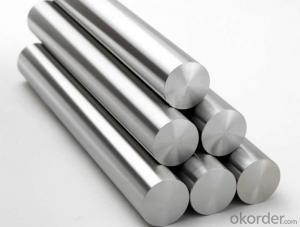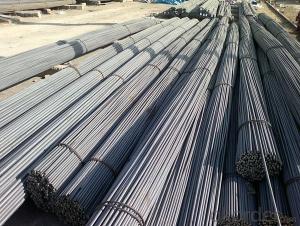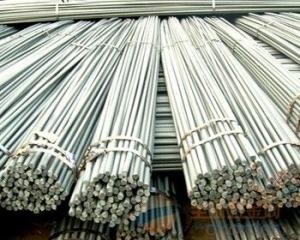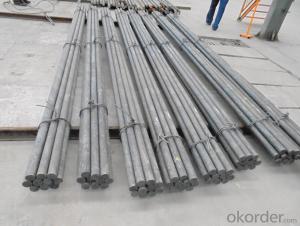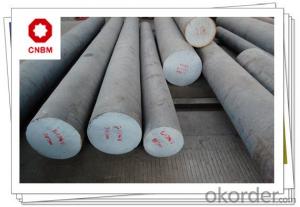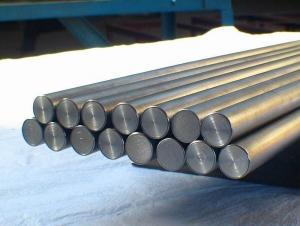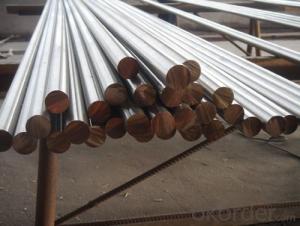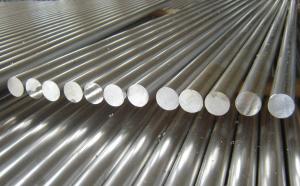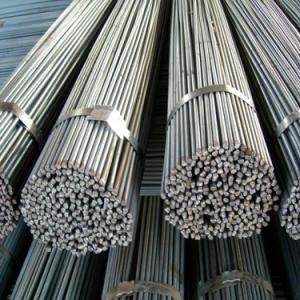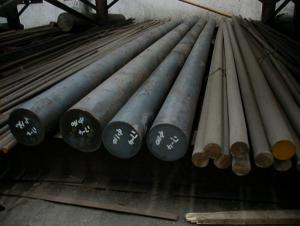High Quality Round Bar 5-28mm Hot Rolled GB Q235 Q195
- Loading Port:
- China Main Port
- Payment Terms:
- TT or LC
- Min Order Qty:
- 25 m.t.
- Supply Capability:
- 100000 m.t./month
OKorder Service Pledge
OKorder Financial Service
You Might Also Like
Product Applications:
1) Suitable for making various strong cutting tool abrasion resistance, impact resistance.
2) Used to produce all kinds of high hard and super hard saw blade, drill, tap, broach, gear hob and various kinds of milling cutter.
3) Used for advanced punching die, screw die, and the toughness and complicated shape of the punch, etc.
4) Is used for cold forging die and drawing mode, etc.
5) Recommended watchcase factory, screw factory and other cold stamping products industry use.
Product Advantages:
OKorder's High Quality Round Bar 5-28mm Hot Rolled GB Q235 Q195are durable, strong, and resist corrosion.
Main Product Features:
· Premium quality
· Prompt delivery & seaworthy packing (30 days after receiving deposit)
· Corrosion resistance
· Can be recycled and reused
· Mill test certification
· Professional Service
· Competitive pricing
Product Specifications:
1. Grade: GB, JIS, ASTM, EN
2. Grade: Q235, SS400, A36, S235JR
3. Diameter and mass: As below
Diameter | Mass | Diameter | Mass | Diameter | Mass |
(mm) | (kg/m) | (mm) | (kg/m) | (mm) | (kg/m) |
6 | 0.22 | 22 | 2.98 | 53 | 17.30 |
7 | 0.30 | 24 | 3.55 | 56 | 19.30 |
8 | 0.40 | 25 | 3.85 | 60 | 22.20 |
9 | 0.50 | 26 | 4.17 | 63 | 24.50 |
10 | 0.62 | 28 | 4.83 | 65 | 26.00 |
11 | 0.75 | 30 | 5.55 | 70 | 30.20 |
12 | 0.89 | 32 | 6.31 | 75 | 34.70 |
13 | 1.04 | 34 | 7.13 | 80 | 39.50 |
14 | 1.21 | 36 | 7.99 | 85 | 44.50 |
15 | 1.39 | 38 | 8.90 | 90 | 49.90 |
16 | 1.58 | 40 | 9.86 | 95 | 55.60 |
17 | 1.78 | 42 | 10.90 | 100 | 61.70 |
18 | 2.00 | 45 | 12.50 | 120 | 88.85 |
19 | 2.23 | 48 | 14.20 | 140 | 120.93 |
20 | 2.47 | 50 | 15.40 | 150 | 138.82 |
4. Material: Mild Steel
5. Heat treatment of high quality steel:
Fire: Isothermal annealing temperature is 800 ~ 880 °C, with 10 ~ 20 °C, the furnace cooling to about 600 °C, hardness above HB269.
Preheat temperature: 730-730 °C
Quenching temperature: 1190-1210 °C
Tempering temperature: 540-595 °C
Cold drawn, hardness 285 HBS
Cold drawn after annealing condition, hardness 277 HBS
Quenching methods: oil quenching, air cooling or salt bath quenching
FAQ:
Q1: Why buy Materials & Equipment from OKorder.com?
A1: All products offered byOKorder.com are carefully selected from China's most reliable manufacturing enterprises. Through its ISO certifications, OKorder.com adheres to the highest standards and a commitment to supply chain safety and customer satisfaction.
Q2: How do we guarantee the quality of our products?
A2: We have established an advanced quality management system which conducts strict quality tests at every step, from raw materials to the final product. At the same time, we provide extensive follow-up service assurances as required.
Q3: How soon can we receive the product after purchase?
A3: Within three days of placing an order, we will begin production. The specific shipping date is dependent upon international and government factors, but is typically 7 to 10 workdays.
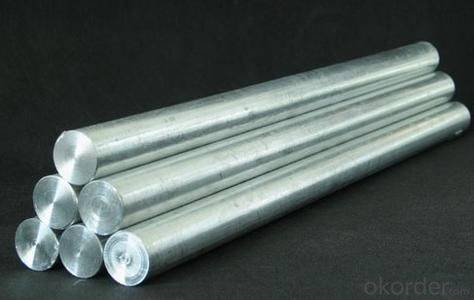
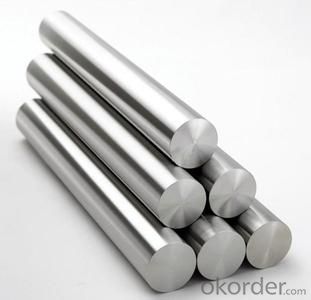
- Q: How do you store steel round bars to prevent damage?
- To prevent damage to steel round bars, they should be stored in a clean and dry environment, away from moisture and direct sunlight. It is recommended to store them horizontally on a flat surface or on racks, ensuring they are not stacked too high to avoid bending or warping. Additionally, using protective coverings or plastic caps on the ends can help prevent any potential scratches or dents during storage.
- Q: What kind of steel is used for anchor bolt material? What's the quality of anchor bolt material?
- The general anchor bolt is made of Q235 steel, which is round. Rebar (Q345) strength, do nut thread no light round easily.
- Q: Special steel bar steel products used to do what
- Carbon tool steel is high carbon steel basically contains alloy elements, the carbon content in the range of 0.65% ~ 1.35%, the production of low cost, easy to obtain raw materials, good machinability, after treatment can obtain high hardness and high wear resistance, so it is widely used in steel, used to manufacture all kinds of cutting tools, mold, measuring.
- Q: What are the different types of steel round bar surface finishes used in the construction industry?
- Steel round bars are widely used in the construction industry due to their strength and durability. To meet specific requirements and enhance performance, these bars undergo various surface finishes. Some common surface finishes used in construction include: 1. Hot Rolled Finish: The most commonly used finish involves heating the steel bar above its recrystallization temperature and rolling it through rollers. This process creates a rough and scale-covered surface. 2. Cold Drawn Finish: This process involves drawing the steel bar through dies to reduce its diameter and increase its length. Cold drawing produces a smooth and shiny surface, ideal for applications where aesthetics and precision are important. 3. Peeled and Polished Finish: This finish includes removing the outer layer of the steel bar through peeling and polishing it to achieve a smooth and mirror-like surface. It is often used in applications that require high visual appeal, such as architectural structures or decorative elements. 4. Ground Finish: Grinding is used to achieve a smooth and uniform surface finish on steel round bars. The process removes imperfections and unevenness, resulting in a precise and polished surface. Ground finishes are commonly used in applications that require tight tolerances, such as machinery or automotive components. 5. Coated Finish: Steel round bars can be coated with various materials, such as galvanized, epoxy, or powder coatings, to enhance corrosion resistance and provide additional properties. These coatings not only protect the steel from environmental factors but also improve its aesthetic appeal. Each surface finish offers unique advantages and is chosen based on specific project requirements. Whether it's for aesthetics, corrosion resistance, or tolerances, selecting the right surface finish is crucial to ensure optimal performance of steel round bars in their intended applications.
- Q: What kind of material is the first round steel?
- [a round bar] is a smooth steel bar. The title of the old bar code, usually called HPB300, is a grade bar, H (Hot-rolled) means hot rolled, P (Plain) is smooth, B (Bar) is strip, where steel is used, and 300 represents yield strength of 300 MPa
- Q: What is the tolerance for length in steel round bars?
- The tolerance for length in steel round bars can vary depending on the specific manufacturing standards and requirements. Generally, the tolerance for length in steel round bars is typically specified in terms of a maximum allowable deviation from the desired or nominal length. This deviation is often expressed as a percentage or as a specific measurement in units such as millimeters or inches. Different international standards organizations, such as the American Society for Testing and Materials (ASTM) or the International Organization for Standardization (ISO), may have their own specific guidelines for the tolerance in steel round bars. These standards help ensure consistent and reliable measurements throughout the industry. In practice, the tolerance for length in steel round bars can range from very tight tolerances of a few millimeters or less, especially for precision applications, to looser tolerances of several centimeters or more for less critical or general-purpose applications. It is important to note that the tolerance for length may also depend on the size and diameter of the steel round bar. Smaller diameter bars may have tighter tolerances compared to larger diameter bars due to the increased difficulty in manufacturing and measuring longer lengths accurately. Ultimately, the specific tolerance for length in steel round bars should be determined based on the intended application and any applicable industry standards or customer specifications.
- Q: Requirements for groove welding of grade 22mm round steel and manual arc welding
- On the lathe, the car C9 chamfer (the car is sharp and difficult to weld, the car's chamfer is too small, the root is not welded).When welding, pull apart the gap of 2mm above the root clearance, the condition allows the edge to rotate while welding, otherwise it can only be welded in all positions.
- Q: What are the advantages of using high-strength steel round bars?
- There are several advantages to using high-strength steel round bars in various applications. Firstly, high-strength steel round bars are known for their exceptional strength-to-weight ratio. This means that even though these bars are lighter in weight compared to other materials, they possess a significantly higher strength. This advantage allows for the construction of structures that are both sturdy and lightweight, making them ideal for applications where weight reduction is crucial, such as in the aerospace and automotive industries. Secondly, high-strength steel round bars offer excellent resistance to wear, fatigue, and impact. This characteristic makes them highly durable and able to withstand heavy loads and repeated stress, enhancing the overall lifespan and performance of structures or components made from these bars. This advantage is particularly beneficial in applications such as construction, where the materials are subjected to extreme conditions and must maintain their structural integrity over time. Furthermore, high-strength steel round bars provide improved design flexibility due to their versatility. They can be easily shaped, machined, and welded, allowing for the creation of complex and customized structures or components. This advantage enables engineers and designers to optimize their designs and achieve specific performance requirements, resulting in more efficient and innovative solutions. In addition, high-strength steel round bars offer enhanced resistance to corrosion, making them suitable for applications where exposure to harsh environmental conditions or corrosive substances is a concern. By utilizing high-strength steel round bars, structures or components can maintain their integrity and functionality for extended periods, reducing the need for frequent maintenance and replacement. Finally, using high-strength steel round bars can lead to cost savings in the long run. Although the initial cost of these bars might be higher compared to other materials, their superior strength and durability can significantly reduce maintenance, repair, and replacement costs over time. Additionally, the lightweight nature of high-strength steel round bars can contribute to fuel efficiency, resulting in cost savings in transportation and other industries. Overall, the advantages of using high-strength steel round bars include high strength-to-weight ratio, excellent resistance to wear and fatigue, improved design flexibility, enhanced corrosion resistance, and potential cost savings. These benefits make high-strength steel round bars a preferred choice for a wide range of applications, ranging from construction and manufacturing to transportation and infrastructure.
- Q: What are the limitations of using steel round bars?
- There are several limitations associated with using steel round bars in various applications. One limitation is their susceptibility to corrosion. Steel round bars, especially those made of carbon steel, are prone to rusting when exposed to moisture or certain harsh environments. This can significantly impact their structural integrity and lifespan. Another limitation is their weight. Steel is a heavy material, and round bars can be particularly cumbersome to handle and transport, especially in large quantities. This can make the installation process more challenging and increase the overall cost of a project. Additionally, steel round bars may not be suitable for applications requiring high levels of flexibility or bending. Due to their rigid nature, they can be difficult to shape or mold into intricate designs. This limitation may restrict their use in certain industries or architectural designs that demand more versatile materials. Another factor to consider is the cost of steel round bars. Depending on the grade and quality of the steel, as well as market conditions, the price of steel round bars can fluctuate significantly. This can pose a financial limitation for projects with tight budgets or when the cost of raw materials is a critical factor. Lastly, steel round bars may not be suitable for applications requiring high resistance to extreme temperatures. While steel has good thermal conductivity, certain temperature ranges can affect its structural properties, leading to potential weaknesses or deformations. Overall, while steel round bars are widely used and offer many advantages, it is essential to consider their limitations such as susceptibility to corrosion, weight, limited flexibility, cost, and temperature sensitivity when selecting materials for specific applications.
- Q: What are the advantages of using steel round bars?
- There are several advantages of using steel round bars in various applications. Firstly, steel round bars are known for their exceptional strength and durability. This makes them ideal for use in construction projects, as they can withstand heavy loads and provide structural integrity. Additionally, steel round bars have excellent resistance to corrosion, making them suitable for outdoor and marine applications. They can withstand exposure to harsh weather conditions and remain unaffected by moisture and chemicals. This ensures a longer lifespan and reduced maintenance costs. Steel round bars also offer versatility in terms of their shape and size. They can be easily customized and fabricated to meet specific requirements, making them suitable for a wide range of applications. Whether it's for construction, manufacturing, or engineering projects, steel round bars can be tailored to fit the desired dimensions and specifications. Furthermore, steel round bars have excellent machinability, allowing for easy cutting, drilling, and shaping. This makes them highly adaptable and easy to work with, saving time and effort during the fabrication process. Moreover, steel round bars have a high tensile strength, which means they can resist deformation under pressure. This makes them ideal for applications where a high level of strength is required, such as in the manufacturing of machinery, tools, and automotive components. Lastly, steel round bars are cost-effective compared to other materials. Their durability and long lifespan result in reduced maintenance and replacement costs over time. Additionally, their availability and widespread use make them a cost-efficient option for various industries. Overall, the advantages of using steel round bars include their exceptional strength, resistance to corrosion, versatility, machinability, high tensile strength, and cost-effectiveness. These qualities make them a popular choice in numerous applications, contributing to their widespread usage in industries worldwide.
Send your message to us
High Quality Round Bar 5-28mm Hot Rolled GB Q235 Q195
- Loading Port:
- China Main Port
- Payment Terms:
- TT or LC
- Min Order Qty:
- 25 m.t.
- Supply Capability:
- 100000 m.t./month
OKorder Service Pledge
OKorder Financial Service
Similar products
Hot products
Hot Searches
Related keywords


